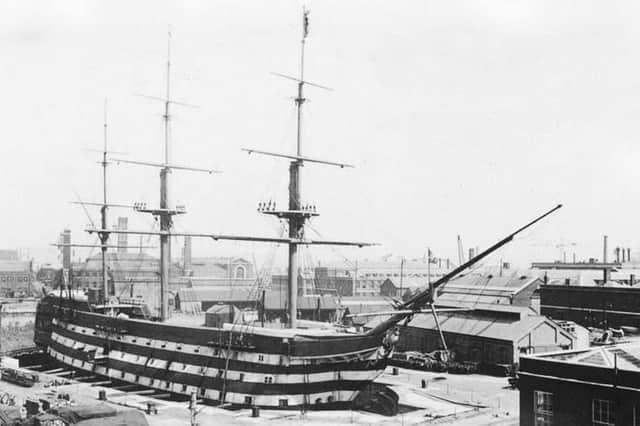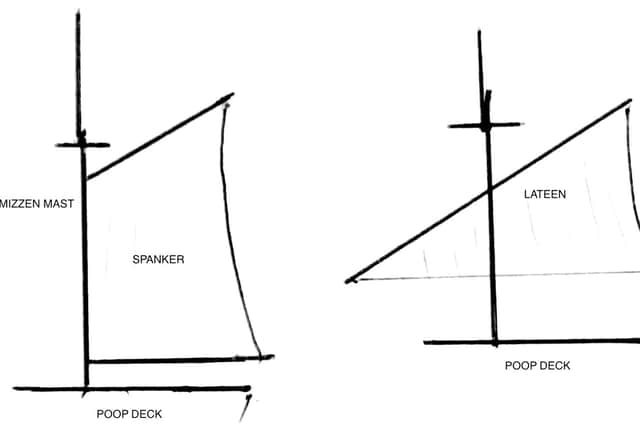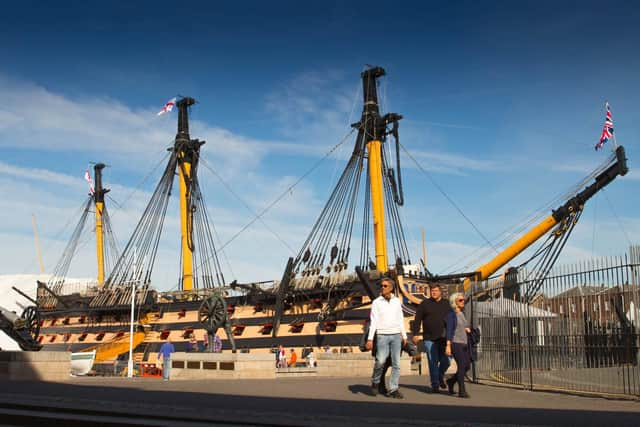How HMS Victory once sailed '“Â Nostalgia


Having said that, the rig for which   we all know and love Victory was not the rig she was built  with.
Back in the day her mizzen mast, the one nearest  the stern, carried a lateen triangular sail which was updated and modernised into what is called a spanker with the sail set between the jib boom and gaff.
Advertisement
Hide AdAdvertisement
Hide AdIn a lateen rig the gaff would have stretched down to the quarter deck and a triangular sail set.


After the battle of Cape St Vincent in 1796, Victory was sent home to Chatham Dockyard  to act as a prison-hospital ship for two years.
In 1801, after a complete overhaul, the lateen sail was replaced by a spanker.
However, this was possibly done earlier as, in 1792, as a   William Nicholson wrote, in a treatise on seamanship: 'The spanker, it being the most extraordinary inconsistent, disproportioned and useless sail that has ever been invented by men of sense and reason.. .'Â
Advertisement
Hide AdAdvertisement
Hide AdThe lateen was supposed to keep the ship to the wind and the seamen only had to push on the end of the yard across the quarter deck to bring the ship to wind. With the spanker it took some time before the sail could be brought round into the wind.


Mind you, Nicholson's thoughts were not taken up as in future years, right through to the great clipper days of the 1840s to 1870s, the spanker was retained.
'¢Â Next Friday (October 12) at 7.30pm, there is a get-together in the pavilion at  Havant Park to mark the 40th anniversary of the current Havant Athletic Club.
Peter Spencer has been in touch seeking help in  trying to trace the hundreds of athletes who have been members over the years. He wants t  o invite them along for a social evening and to  exchange memories.
Advertisement
Hide AdAdvertisement
Hide AdHe says:Â 'There were earlier clubs between 1889 and 1914, and another between 1930 and 1955.
'˜We only know of the 1889 date because we have an events programme for that year , so it could have been earlier still. So Havant Athletic Club has been in existence a cumulative total of 90 years.Â
'We will be asking people to sign up for the 100th anniversary in case the numbers exceed the space in the clubhouse!
'˜Â We do have people attending who were members during the time of the second club.
Advertisement
Hide AdAdvertisement
Hide Ad'˜Â We are asking for people with any information and photographs they could share  '“ we do have an aerial photo of the track laid out in Havant Park before 1955.'Â
Can any readers help Peter with memorabilia?
'¢Â In a book I was given about Portsmouth in 1911 there is a report on the water which apparently was much sweeter then  as it came from beneath the seabed.
As we know, Portsea Island is flat with no part rising more than 30ft above sea level while a considerable area to the east, such as Great Salterns, is below sea level having only been reclaimed in the past 300 years.
In years past, water could generally be obtained from shallow wells sunk across the island , but the quality was indifferent and the risk of contamination considerable.
Advertisement
Hide AdAdvertisement
Hide AdA remarkable supply of water is worth noting in the case of the circular forts in the Solent.
 Each fort had a bore sunk between 500ft and 600ft through the seabed to find a good supply of fresh water.
 In the dockyard a disused well was reported to have penetrated through the chalk to a depth of 1,034f t.
n There was a time when funeral directors had their premises, perhaps not in back streets, but definitely not o n high streets .
Advertisement
Hide AdAdvertisement
Hide Ad It's very different today with, it seems, parlours opening up  on every street corner.
Last Wednesday I was in Chichester looking around the street market and in both North Street and East Street  there were stalls, for that is what they were, urging passers-by to book their funeral.
I kid you not, and I am sure I am not t he only who thinks this is  all in extremely bad taste.
Newspapers are full of the wares on offer from funeral directors, not to mention funeral plans advertised on the television.
Advertisement
Hide AdAdvertisement
Hide Ad There seems to be  nothing discreet about a funeral director/undertaker any longer, that's for sure .
As someone who has lost many members of my family in the past  few years I know just how much a funeral costs these days and it is not cheap, not that it should be of course.
 These adverts are a continuous reminder of people we have lost in my opinion and I wish they would disappear into the shadows once more.
 We all know where we can find one when the time comes.
Â
Â
Â
Â
Â
Â
Â
Â
Â
Â
Â
Â
Â
Â
Â
Â
Â
Â
Â
Â
Â
Â
Â
Â
Â
Â
Â
Â
Â
Â
Â
Â
Â
Â
Â
Â
Â
Â
Â
Â
Â
Â
Â
Â
Â
Â
Â
Â
Â
Â
Â